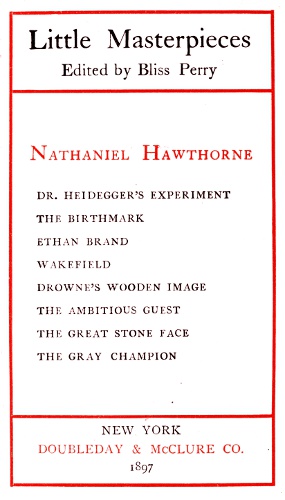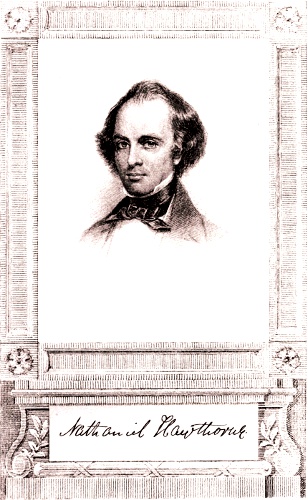

Little Masterpieces
Edited by Bliss Perry
Nathaniel Hawthorne
| DR. HEIDEGGER'S EXPERIMENT |
| THE BIRTHMARK |
| ETHAN BRAND |
| WAKEFIELD |
| DROWNE'S WOODEN IMAGE |
| THE AMBITIOUS GUEST |
| THE GREAT STONE FACE |
| THE GRAY CHAMPION |
NEW YORK
DOUBLEDAY & McCLURE CO.
1897
Copyright, 1897, by
Doubleday & McClure Co.
These selections are used by special arrangement with
Messrs. Houghton, Mifflin & Co., the authorized
publishers of Hawthorne's works.
McClure Press
New York City
Introduction
Hawthorne made three collections of his short stories and sketches:"Twice-Told Tales," "Mosses from an Old Manse," and "The Snow Image andOther Tales." The prefaces to these volumes express, with characteristiccharm, the author's dissatisfaction with his handiwork. No critic haspointed out so clearly as Hawthorne himself the ineffectiveness of someof the "Twice-Told Tales"; he thinks that the "Mosses from an Old Manse"afford no solid basis for a literary reputation; and his comment uponthe earlier and later work gathered indiscriminately into his finalvolume is that "the ripened autumnal fruit tastes but little better thanthe early windfalls."
It must be remembered that the collections were made in desultoryfashion. They included some work that Hawthorne had outgrown even whenthe first volume was published, such as elaborate exercises indescription and fanciful allegories, excellently composed but withoutsubstance. Yet side by side with these proofs of his long, wearyapprenticeship are stories that reveal the consummate artist, mature inmind and heart, and with the sure hand of the master. The qualities ofimagination and style that place Hawthorne easily first among Americanwriters of fiction are as readily discernible in his best brief tales asin his romances.
"Dr. Heidegger's Experiment," with which the present volume opens, isHawthorne's earliest treatment of the elixir of immortality theme, whichhaunted him throughout his life and was the subject of the unfinishedromance which rested upon his coffin. He handles it daintily, poeticallyhere, with an irony at once exquisite and profound. "The Birthmark"represents another favorite theme: the rivalry between scientificpassion and human affection. It is not wholly free from the morbid fancywhich Hawthorne occasionally betrays, and which allies him, on one sideof his many-gifted mind, with Edgar Allan Poe; but the essential sanityof Hawthorne's moral, and the perfection of the workmanship, render "TheBirthmark" worthy of its high place among modern short stories. "EthanBrand" dates obviously from the sojourn at North Adams, Massachusetts,described in the "American Note-Book." Fragmentary as it is, it is oneof Hawthorne's most powerful pieces of writing, the Unpardonable Sinwhich it portrays—the development of the intellect at the expense ofthe heart—being one which the lonely romancer himself had had cause todread. The motive of the humorous character sketch entitled "Wakefield"is somewhat similar: the danger of stepping aside, even for a moment,from one's allotted place. "Drowne's Wooden Image" is a charmi